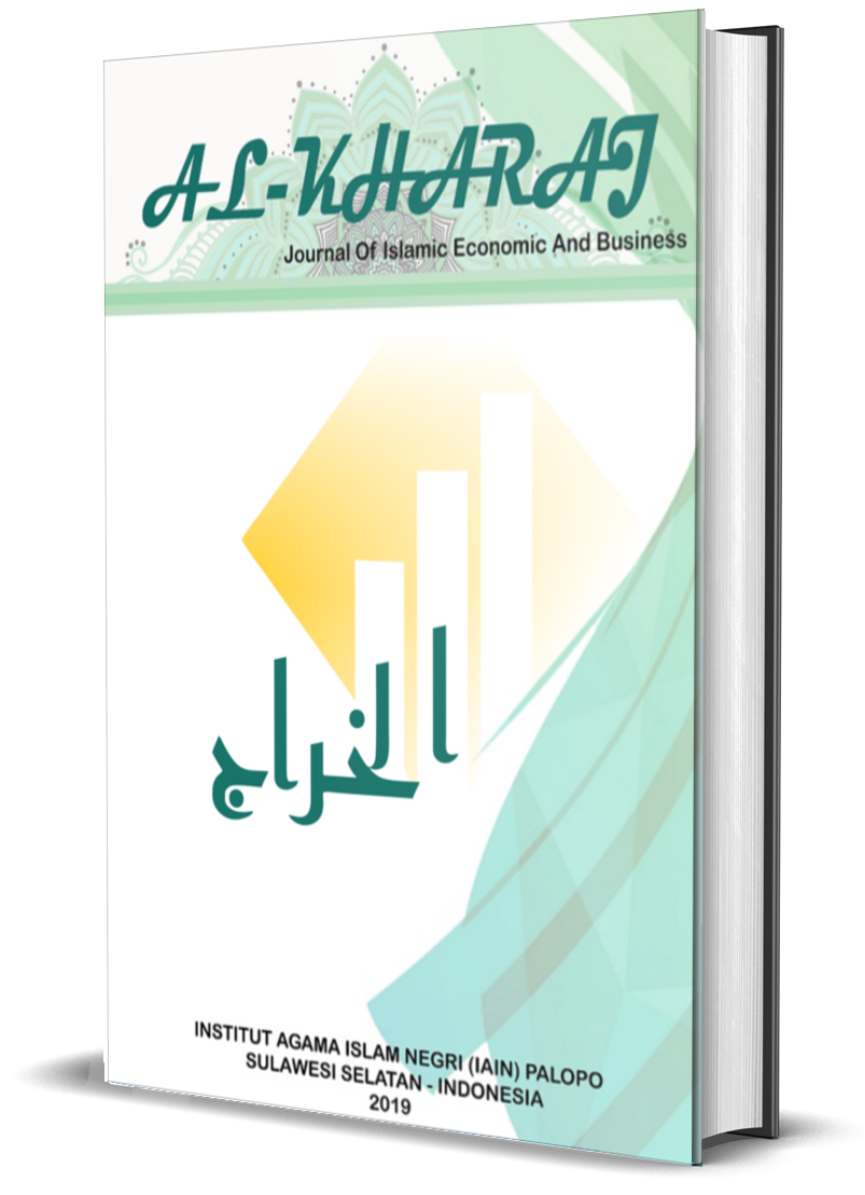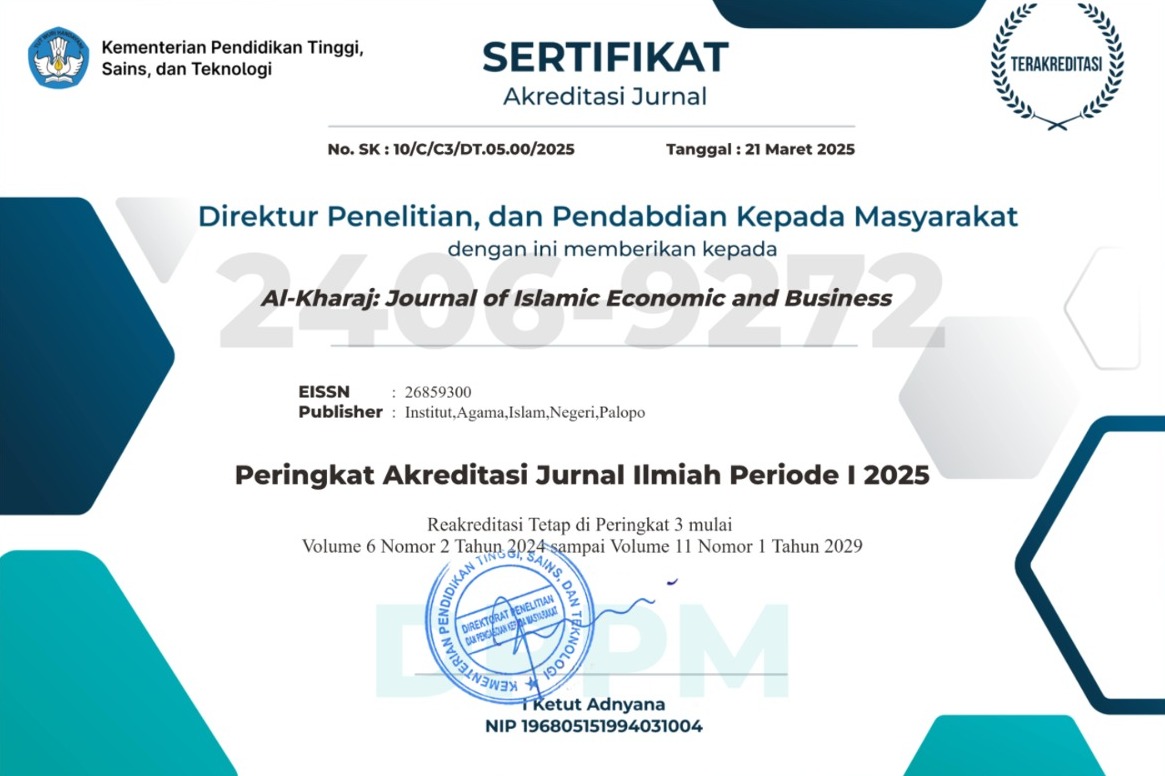Sustainable Banking Practices and Cost Efficiency: Evidence on Profitability from Islamic Commercial Banks in Indonesia
DOI:
https://doi.org/10.24256/kharaj.v7i2.7359Keywords:
Green Banking, Eficiency Cost, Profitability, Syariah BankAbstract
This study aims to examine the effect of green banking implementation and operational cost efficiency on the profitability of Islamic Commercial Banks in Indonesia during the period 2020–2024. The variables used in this study include green banking as an exogenous variable, operational efficiency (BOPO) as an independent variable, and return on assets (ROA) as a measure of profitability. This quantitative study employs secondary panel data sourced from the annual reports of Islamic Commercial Banks registered with the Financial Services Authority (OJK). The analysis uses a path model approach. The results reveal that green banking has a positive and significant effect on ROA while BOPO has a significant negative effect on ROA. Simultaneous testing found that the implementation of green banking as measured by GCR and BOPO had a positive and significant influence on ROA.These findings indicate that sustainable banking practices and cost efficiency play a critical role in enhancing the financial performance of Islamic banks in Indonesia.
References
Ahsan, T., & Qureshi, M. A. (2022). The Impact Of Islamic Banking Model And Islamic Financial Development On Bank Performance: Evidence From Dual Banking Economies. International Journal Of Islamic And Middle Eastern Finance And Management, 15(3), 602–625.
Ai’ni Rahma Dewi, S., & Pamungkas, I. D. (2024). Peran Green Banking Sebagai Pemoderasi Pada Determinan Kinerja Keuangan Bank Umum Syariah Periode 2018-2022. Al-Kharaj: Jurnal Ekonomi, Keuangan & Bisnis Syariah, 6(6), 3717–3733. Https://Doi.Org/10.47467/Alkharaj.V6i6.1175
Ayu, E. P., & Nurulrahmatiah, N. (2023). Analisis Tingkat Kesehatan Bank Dengan Menggunakan Metode CAMEL Pada Perbankan BUMN Yang Terdaftar Di BEI Tahun 2017-2021. J-CEKI : Jurnal Cendekia Ilmiah, 2(6), 676–692.
Azhgaliyeva, D., & Liddle, B. (2020). Introduction To The Special Issue: Scaling Up Green Finance In Asia. Journal Of Sustainable Finance And Investment, 10(2), 83–91. Https://Doi.Org/10.1080/20430795.2020.1736491
Bose, S., Khan, H. Z., Rashid, A., & Islam, S. (2018). What Drives Green Banking Disclosure? An Institutional And Corporate Governance Perspective. Asia Pacific Journal Of Management, 35(2), 501–527.
Bouteraa, M., Rizal Iskandar Bin Raja Hisham, R., & Zainol, Z. (2020). Green Banking Practices From Islamic And Western Perspectives. International Journal Of Business, Economics And Law, 21(5), 1–11.
Chowdhury, M. M. (2023). Green Finance And Bank Performance: Evidence From Bangladesh. International Journal Of Multidisciplinary Research And Analysis, 06(06), 2354–2362. Https://Doi.Org/10.47191/Ijmra/V6-I6-28
Fathihani, Saputra, J., Haat, M. H. C., Yusliza, M. Y., Muhammad, Z., & Bon, A. T. (2021). A Review Of Sustainable Green Finance Literature: Mini-Review Approach. Proceedings Of The International Conference On Industrial Engineering And Operations Management, July, 3194–3207.
Febry Malangi, N., Maulana, H. I., Nurman, Ramli, A., & Mustika Amin, A. (2023). Analisis Tingkat Kesehatan Bank Menggunakan Metodecamel (Capital, Asset Quality, Management Dan Liquidity)(Studi Kasus Pt. Bank Sulselbar Periode 2016-2021). 1(2), 115–128.
Felani, H., Wahyuni, S., & Pratama, B. C. (2020). The Analysis Effect Of Islamicity Performance Index On The Financial Performance Of Sharia Commercial Banks In Indonesia. Journal Of Economics Research And Social Sciences, 4(2), 129–139. Https://Doi.Org/10.18196/Jerss.V4i2.8389
Fransiskus Freklindo, Yosefina Andia Dekratia, & Magdalena Samosir. (2023). Analisis Kinerja Keuangan Dengan Menggunakan Metode CAMEL Pada PT. Bank Rakyat Indonesia (Persero) Tbk. Jurnal Kewirausahaan Dan Manajemen Bisnis: Cuan, 1(2), 146–159.
Hadinata, S. (2019). Islamic Social Reporting Index Dan Kinerja Keuangan Pada Perbankan Syariah Di Indonesia. Ekbis: Jurnal Ekonomi Dan Bisnis, 2(1), 72. Https://Doi.Org/10.14421/Ekbis.2018.2.1.1099
Harfian, M. J. (2021). Analisis Tingkat Kesehatan Bank Syariah Dengan Menggunakan Metode Capital, Asset Quality, Management, Earning, Liability (CAMEL) Pada Bank PT. Muamalat
Hasibuan, P. R. P. (2021). Analisis Tingkat Kesehatan PT. Bank Central Asia (BCA) Syariah Dengan Metode CAMEL. Http://Etd.Iain-
Hoque, M. K., Masum, M. H., & Babu, M. A. (2022). Impact Of Financial Performance On Green Banking Disclosure: Evidence From The Listed Banking Companies In Bangladesh. Universal Journal Of Accounting And Finance, 10(2), 450–456. Https://Doi.Org/10.13189/Ujaf.2022.100209
Karyani, E., & Obrien, V. V. (2020). Green Banking And Performance: The Role Of Foreign And Public Ownership. Jurnal Dinamika Akuntansi Dan Bisnis, 7(2), 221–234. Https://Doi.Org/10.24815/Jdab.V7i2.17150
Kweeswara, C. O., & Irawan, J. F. P. (2023). Green Banking, Kesehatan Bank Dan Profitabilitas Dengan Corporate Social Responsibility Sebagai Variabel Moderasi. E-Jurnal Akuntansi, 33(4), 968.
Lubis, M. Z. M., Putra, G. D. A., & Husna, H. (2023). Pengukuran Kinerja Keuangan Bank Syariah Indonesia Pasca Merger Menggunakan Pendekatan Islamicity Performance Index. Jurnal Informatika Ekonomi Bisnis, 5, 312–317. Https://Doi.Org/10.37034/Infeb.V5i2.234
Maryanti, M., Putra, F., Ariyanto, E., & Anwar, A. (2021). Banking Sustainability In Indonesia. Https://Doi.Org/10.4108/Eai.6-3-2021.2305976
Nst, A. I. L., Siregar, D. A., & Taufiq. (2020). The Effect Of Intellectual Capital On The Performance Of Islamic Banks Based On The Islamicity Performance Index (Case Study Of Sharia Commercial Banks For The Period 2014-2018). Journal Of Management And Business Innovations, 01, 21–32.
Nur Ajizah, S. D., & Agus Widarjono. (2023). Indonesia Islamic Banking Stability In The Shadow Of Covid-19 Outbreak. Jurnal Ekonomi Syariah Teori Dan Terapan, 10(1), 57–68. Https://Doi.Org/10.20473/Vol10iss20231pp57-68
Nurmalia, G. (2021). Green Banking Dan Rasio Kecukupan Modal Mempengaruhi Pertumbuhan Laba Bank Umum Syariah Di Indonesia. Jurnal Ilmiah Keuangan Dan Perbankan, 4(2), 173–187.
Putri1, A., Prasitha2, N., Ceasario3, A. F., & Oktafia, R. (2024). Analisis Rasio Camel Pada Tingkat Kesehatan Perbankan Syariah (Studi Kasus Pada Bank Bca Syariah Dan Bank Muamalat Periode 2018-2019). 2(1), 303–6478.
Ratnasari, T., Surwanti, A., & Pribadi, F. (2021). Implementation Of Green Banking And Financial Performance On Commercial Banks In Indonesia. International Symposia In Economic Theory And Econometrics, 28, 323–336. Https://Doi.Org/10.1108/S1571-038620210000028018
Rizma Novita Sari, & Farah Wulandari Pangestuty. (2024). Analisis Faktor Yang Mempengaruhi Stabilitas Perbankan Syariah Dan Konvensional Di Indonesia Periode 2008-2022. Islamic Economics And Finance In Focus, 3(2), 419–432. Https://Doi.Org/10.21776/Ieff.2024.03.02.15
Sharmeen, K., & Yeaman, A. M. (2020). Benefits That Islamic And Conventional Banks Can Attain By Implementing Green Banking. Journal Of Islamic Monetary Economics And Finance, 6(4), 833–860.
Siyamto, Y. (2023). Bank Performance In Achieving Islamic Bank Stability Conditions: Evidence From Islamic Banks In Indonesia. Proceedings Series On Social Sciences & Humanities, 12, 347–354.
Wayan Budiasa, I. (2020). Green Financing For Supporting Sustainable Agriculture In Indonesia. IOP Conference Series: Earth And Environmental Science, 518(1). Https://Doi.Org/10.1088/1755-1315/518/1/012042
Windasari Rachmawati. (2023). A Systematic Review On Green Banking Disclosure. International Conference On Digital Advance Tourism, Management And Technology, 1(2), 512–525.
Ziolo, M. (2021). The Role Of Sustainable Finance In Achieving Sustainable Development Goals : Does It Work ? 27(1), 45–70.
Downloads
Published
How to Cite
Issue
Section
Citation Check
License
Copyright (c) 2025 Fathihani, Rini Sulistiyowati, Hendra Kusuma

This work is licensed under a Creative Commons Attribution-ShareAlike 4.0 International License.
Authors retain copyright and grant the journal right of first publication with the work simultaneously licensed under a Creative Commons Attribution-ShareAlike 4.0 International License. In line with the license, authors are allowed to share and adapt the material. In addition, the material must be given appropriate credit, provided with a link to the license, and indicated if changes were made. If authors remix, transform or build upon the material, authors must distribute their contributions under the same license as the original.









